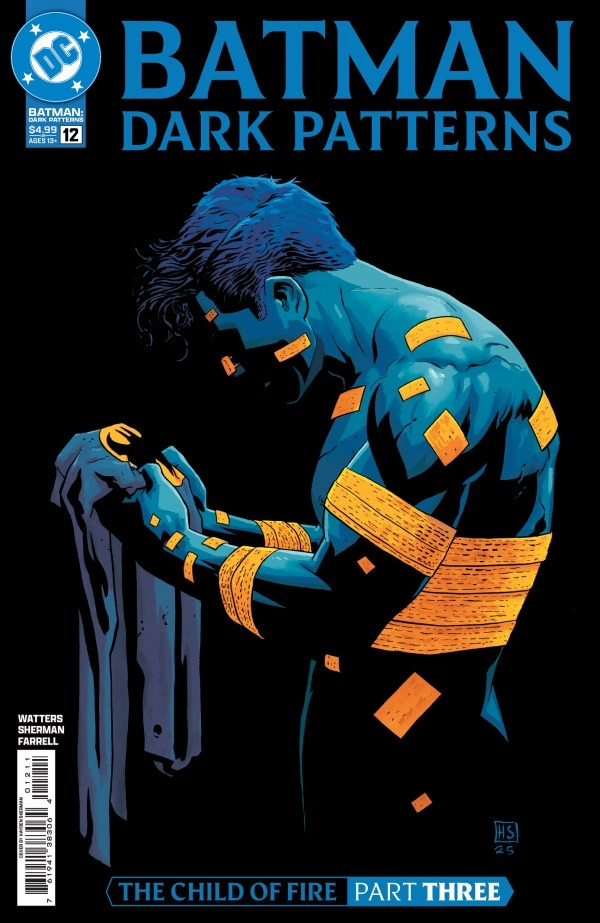And so we come to the final issue of one of the best Batman books in years.
Batman: Dark Patterns comes to a close with the third part of “The Child of Fire,” a finale that manages to bring together this arc and provide more context to the previous arcs. The showdown is between the titular Child of Fire Nicky Harris and Batman. But the showdown is also between fact and myth, chaos and order, old Gotham and new. If that sounds like a lot well, it is, but Watters, Sherman, and co. bring it all together nicely.
At the end of the previous issue, Batman was fighting through a fever, and Alfred raced out and stopped the fire he knew was coming once he figured out the pattern. His failure was still affecting his body through infection and his mind through a creeping sense of madness. Recall the scene in Wayne Manor, everything laid out on the floor with Bruce babbling about treating Gotham like a body with wound patterns. A far cry from his discipline in previous issues against imagining things that might not be there. But once Alfred forces him to take some care of himself and offhandedly remarks that the name “Child of Fire” sounds like something a tabloid journalist like Nicky Harris would make up, Batman’s off and running again. It’s always nice to see Alfred contribute. Something’s still not quite right, though. What does Batman mean when he contacts Gordon en route to warn him that the next great fire of Gotham might be inside him?
There’s not much time to figure any of that out as this issue begins with Harris’s firebombs in place and the Financial District ablaze. The first showdown is between Dr. Sereika and Nicky, who has decided that they can’t coexist because of what they each represent. So the fire will be what chooses between the myth-making journalist and the fact-finding doctor to see what kind of Gotham will be left standing. The two of them in their insulated suits and masks, standing in the blazes, make for some spectacular panels, on par with what we’ve come to expect from this book. Notice too the doll face on Harris compared to the skull face on Sereika. It’s here that Harris spells out how he’s tried to involve himself in the previous three arcs. I don’t know if he’s lying, although that would be in line with his views on preferring narratives over truth. But even if he’s telling it exactly how it happened, I’m not sure he can take as much credit as he’s trying to take here. And I think that’s intentional; he sees himself mattering much more than he actually does (not exactly a stretch for a journalist). But this scene leads right into one of the best panels so far: Batman reaching out through the flames to take charge of the scene.
Getting into the specifics of what happens involves a few too many spoilers. But I don’t think it’s too much of a spoiler to say Batman prevents Gotham from burning down. It’s not so much what happens, though, it’s how it happens and how Batman describes it compared to how others tell the story and how it’s shown in these incredible pages. This is where I think a lot of the central questions and conflicts of the book come to the surface. Are Batman’s heroics just those of a very intelligent and driven individual? Is what happens in Gotham the product of regular people leading regular lives in a big city? Or are there larger forces of good and evil at work, beyond what can be tested in a laboratory or explained by forensic evidence? I know we love our grounded Batman around here, but I think at least part of his appeal is that he and his stories bump up against these questions time and again. How couldn’t they? The best stories don’t invent the truth; they reveal it.
There’s nothing more to say about the quality of this book that I haven’t already said. The artwork and panel layout are again incredible. And I love the little details, like a certain red phone on Gordon’s desk. This is the product of a creative team that loves Batman and his history. To get a Batman story with this level of visual quality is a treat. To get one with this much depth to the story is also a treat. But when one book does both? I wouldn’t be surprised if we’re talking about this as a classic in years to come. Can’t wait to pick up the collected edition and experience it all over again. – Trey Jackson

